stop start CHEVROLET TRACKER 1995 Owners Manual
[x] Cancel search | Manufacturer: CHEVROLET, Model Year: 1995, Model line: TRACKER, Model: CHEVROLET TRACKER 1995Pages: 354, PDF Size: 18.24 MB
Page 50 of 354
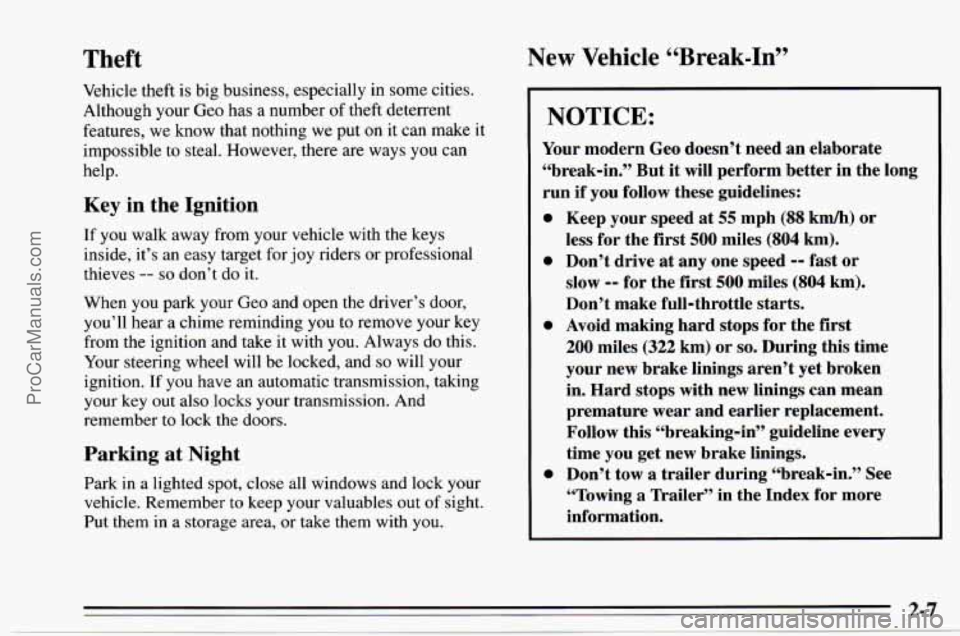
Theft New Vehicle LLBreak-In”
Vehicle theft is big business, especially in some cities.
Although your Geo has
a number of theft deterrent
features, we know that nothing we put on it can make it
impossible to steal. However, there are ways
you can
help.
Key in the Ignition
If you walk away from your vehicle with the keys
inside, it’s an easy target for joy riders or professional
thieves
-- so don’t do it.
When you park your
Geo and open the driver’s door,
you’ll hear
a chime reminding you to remove your key
from the ignition and take it with you. Always do this.
Your steering wheel will be locked, and
so will your
ignition. If you have an automatic transmission, taking
your key out also
locks your transmission. And
remember
to lock the doors.
Parking at Night
Park in a lighted spot, close all windows and lock your
vehicle. Remember to keep your valuables out
of sight.
Put them in
a storage area, or take them with you.
NOTICE:
Your modern Geo doesn’t need an elaborate
“break-in.” But it will perform better in the long
run
if you follow these guidelines:
0
0
0
0
Keep your speed at 55 mph (88 km/h) or
less for the
first 500 miles (804 km).
Don’t drive at any one speed
-- fast or
slow
-- for the first 500 miles (804 km).
Don’t make full-throttle starts.
Avoid making hard stops for the first
200 miles (322 km) or so. During this time
your new brake linings aren’t yet broken
in. Hard stops with new linings can mean
premature wear and earlier replacement.
Follow this “breaking-in” guideline every
time you get new brake linings.
Don’t tow a trailer during “break-in.” See
“Towing a Trailer” in the Index for more
information.
ProCarManuals.com
Page 52 of 354
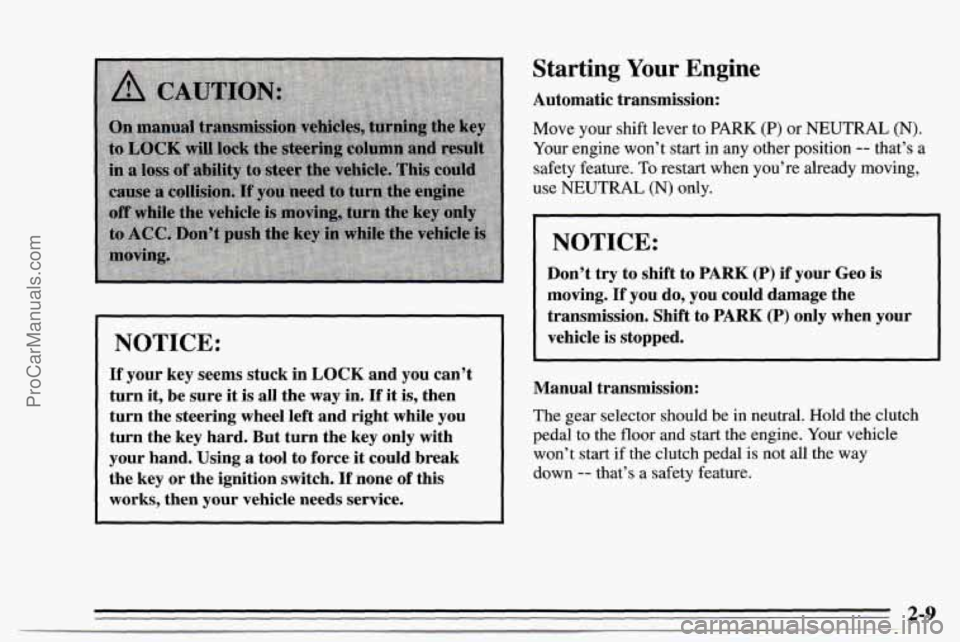
Starting Your Engine
Automatic transmission:
NOTICE:
If your key seems stuck in LOCK and you can’t
turn
it, be sure it is all the way in. If it is, then
turn the steering wheel left and right while you
turn the key hard. But turn the key only with
your hand. Using
a tool to force it could break
the key or the ignition switch.
If none of this
works, then your vehicle needs service.
Move your shift lever to PARK (P) or NEUTRAL (N).
Your engine won’t start in any other position -- that’s a
safety feature.
To restart when you’re already moving,
use NEUTRAL
(N) only,
NOTICE:
Don’t try to shift to PARK (P) if your Geo is
moving. If you do, you could damage the
transmission. Shift to
PARK (P) only when your
vehicle is stopped.
Manual transmission:
The gear selector should be in neutral. Hold the clutch
pedal to the floor and start the engine. Your vehicle
won’t start
if the clutch pedal is not all the way
down
-- that’s a safety feature.
2-9
ProCarManuals.com
Page 55 of 354
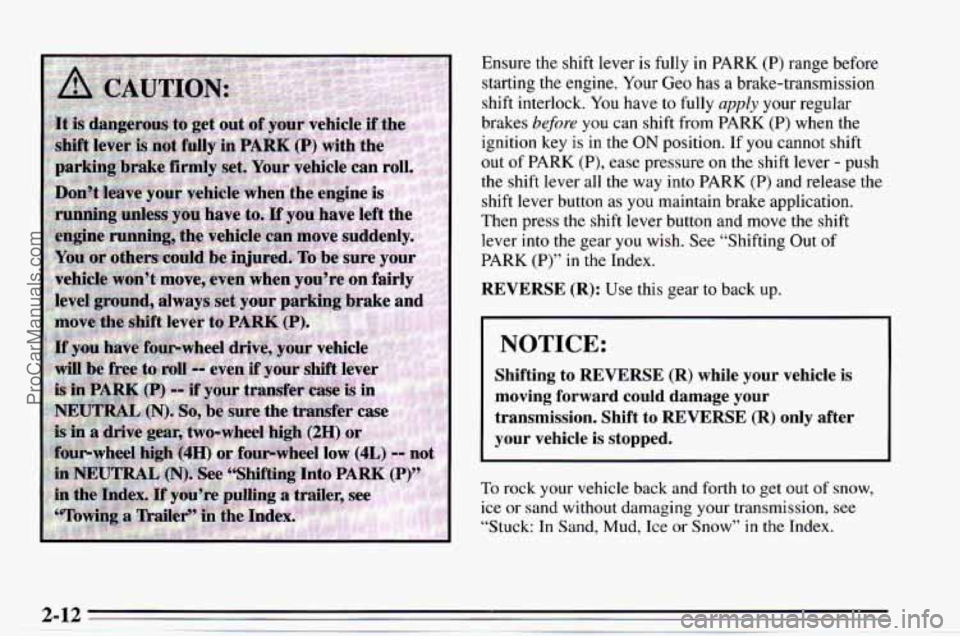
Ensure the shift lever is fully in PARK (P) range before
starting the engine. Your Geo has
a brake-transmission
shift interlock. You have to fully
apply your regular
brakes before
you can shift from PARK (P) when the
ignition key
is in the ON position. If you cannot shift
out
of PARK (P), ease pressure on the shift lever - push
the shift lever all
the way into PARK (P) and release the
shift lever button as
you maintain brake application.
Then press the shift lever button and move the shift
lever into the gear you wish. See “Shifting Out
of
PARK (P)” in the Index.
REVERSE (R): Use this gear to back up.
I
I NOTICE:
Shifting to REVERSE (R) while your vehicle is
moving forward could damage your
transmission. Shift to REVERSE
(R) only after
your vehicle is stopped.
To rock your vehicle back and forth to get out of snow,
ice or sand without damaging your transmission, see
“Stuck: In Sand, Mud, Ice
or Snow” in the Index.
ProCarManuals.com
Page 58 of 354
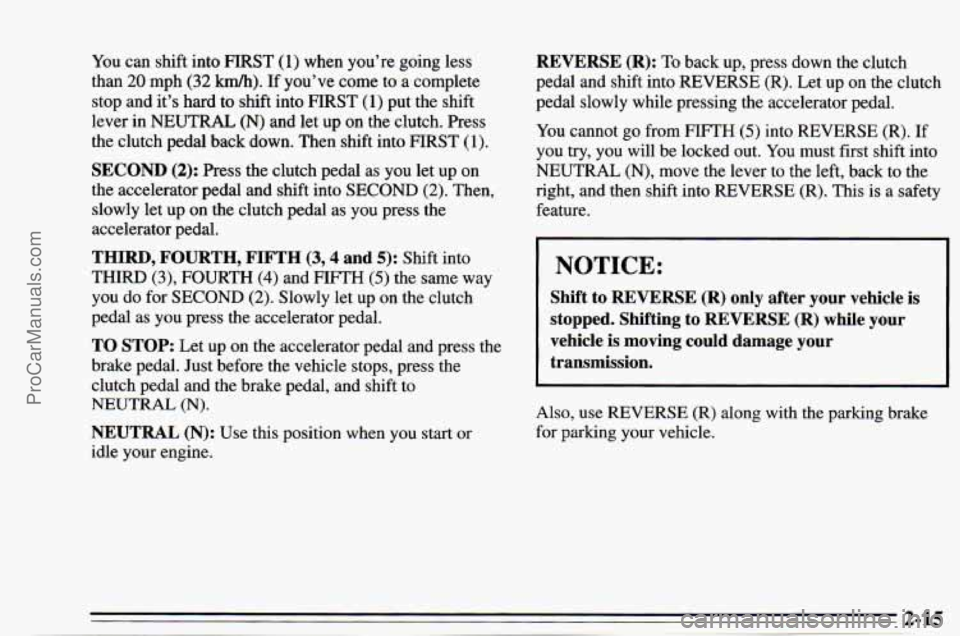
You can shift into F'IRST (1) when you're going less
than
20 mph (32 km/h). If you've come to a complete
stop and it's hard to shift into FIRST
(1) put the shift
lever in NEUTRAL
(N) and let up on the clutch. Press
the clutch pedal back down. Then shift into FIRST
(1).
SECOND (2): Press the clutch pedal as you let up on
the accelerator pedal and shift into SECOND
(2). Then.
slowly let up on the clutch pedal as you press the
accelerator pedal.
THIRD, FOURTH, FIFTH (3,4 and 5): Shift into
THIRD
(3), FOURTH (4) and FIFTH (5) the same way
you do for SECOND
(2). Slowly let up on the clutch
pedal as you press the accelerator pedal.
TO STOP: Let up on the accelerator pedal and press the
brake pedal. Just before the vehicle stops, press the
clutch pedal and the brake pedal, and shift to
NEUTRAL (N).
NEUTRAL (N): Use this position when you start or
idle your engine.
REVERSE (R): To back up, press down the clutch
pedal and shift into REVERSE (R). Let up on the clutch
pedal slowly while pressing the accelerator pedal.
You cannot
go from FIFTH (5) into REVERSE (R). If
you
try, you will be locked out. You must first shift into
NEUTRAL
(N), move the lever to the left, back to the
right, and then shift into REVERSE
(R). This is a safetv
feature.
NOTICE:
Shift to REVERSE (R) only after your vehicle is
stopped. Shifting to REVERSE (R) while your
vehicle is moving could damage your
transmission.
Also, use REVERSE (R) along with the parking brake
for parking your vehicle.
ProCarManuals.com
Page 74 of 354
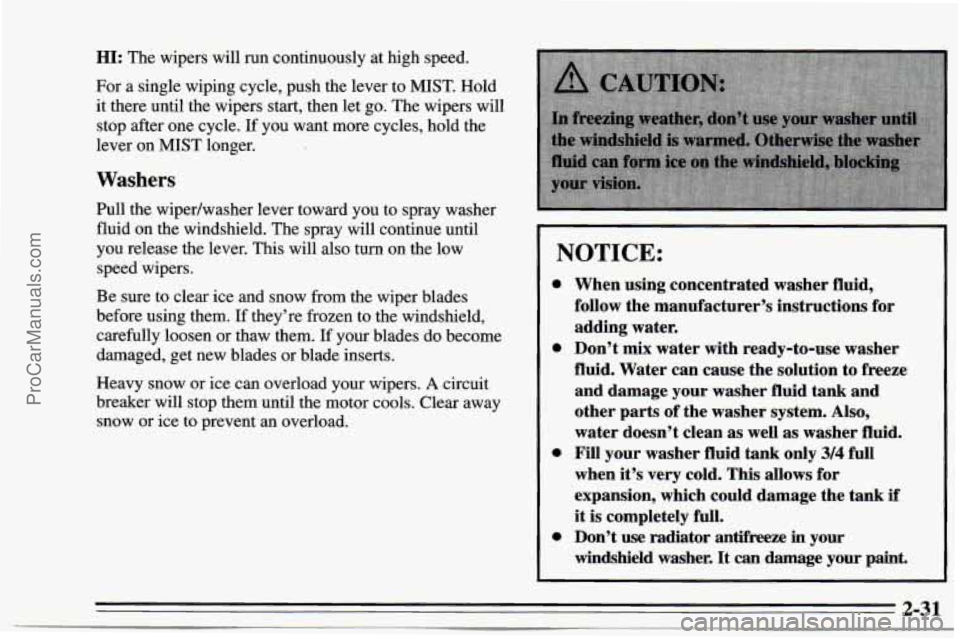
HI: The wipers will run continuously at high speed.
For a single wiping cycle, push the lever to MIST. Hold
it there until the wipers start, then let go. The wipers will
stop after one cycle.
If you want more cycles, hold the
lever on MIST longer.
Washers
Pull the wipedwasher lever toward you to spray washer
fluid on the windshield. The spray will continue until
you release the lever. This will also turn on the low
speed wipers.
Be sure to clear ice and snow from the wiper blades
before using them. If they’re frozen to the windshield,
carefully loosen or thaw them.
If your blades do become
damaged, get new blades or blade inserts.
Heavy snow or ice can overload your wipers.
A circuit
breaker will stop them until the motor cools. Clear away
snow or ice to prevent an overload.
When using concentrated washer fluid,
follow the manufacturer’s instructions for
adding water.
Don’t mix water with ready-to-use washer
fluid. Water can cause the solution to freeze
and damage your washer fluid tank and
other parts
of the washer system. Also,
water doesn’t clean as well as washer fluid.
Fill your washer fluid tank only
3/4 full
when it’s very cold.
This allows for
expansion, which could damage the tank
if
it is completely full.
Don’t
use radiator antifteeze in your
windshield washer.
It can damage your paint.
2-31
ProCarManuals.com
Page 88 of 354
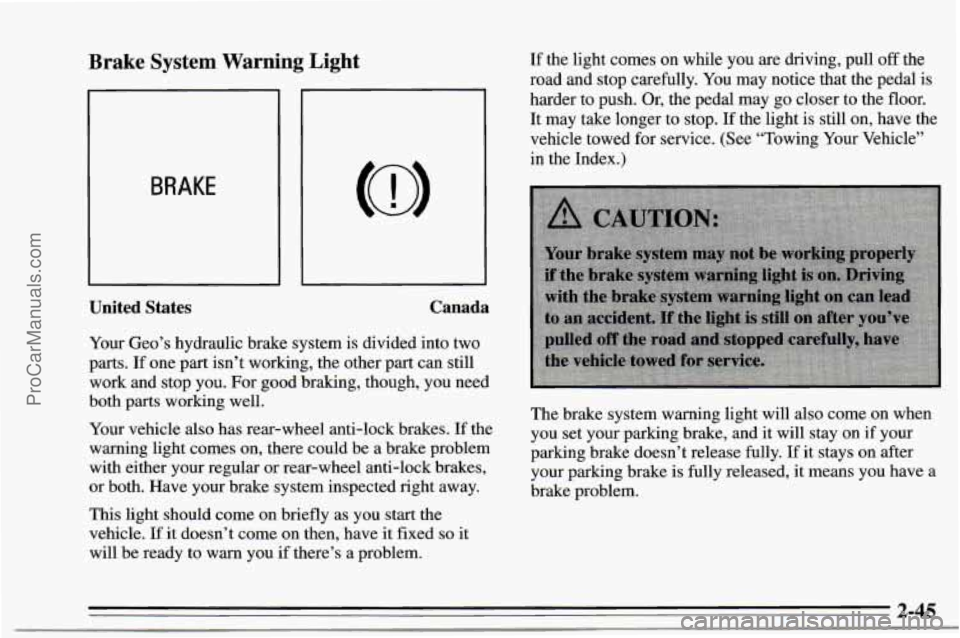
Brake System Warning Light
BRAKE
United States Canada
Your Geo’s
hydraulic brake system is divided into two
parts. If one part isn’t working, the other part can still
work and stop you. For good braking, though, you need
both
parts working well.
Your vehicle also has rear-wheel anti-lock brakes. If the
warning light comes on, there could be a brake problem
with either your regular or rear-wheel anti-lock brakes,
or both. Have your brake system inspected right away.
This light should come on briefly as you start the
vehicle.
If it doesn’t come on then, have it fixed so it
will be ready to warn you if there’s a problem. If
the light comes on while you are driving, pull
off the
road and stop carefully.
You may notice that the pedal is
harder to push. Or, the pedal may
go closer to the floor.
It may take longer to stop.
If the light is still on, have the
vehicle towed
for service. (See “Towing Your Vehicle”
in the Index.)
The brake system warning light will also come on when
you set your parking brake, and it will stay on if your
parking brake doesn’t release fully. If it stays on after
your parking brake is fully released, it means you have
a
brake problem.
~ ..
2-45
ProCarManuals.com
Page 90 of 354
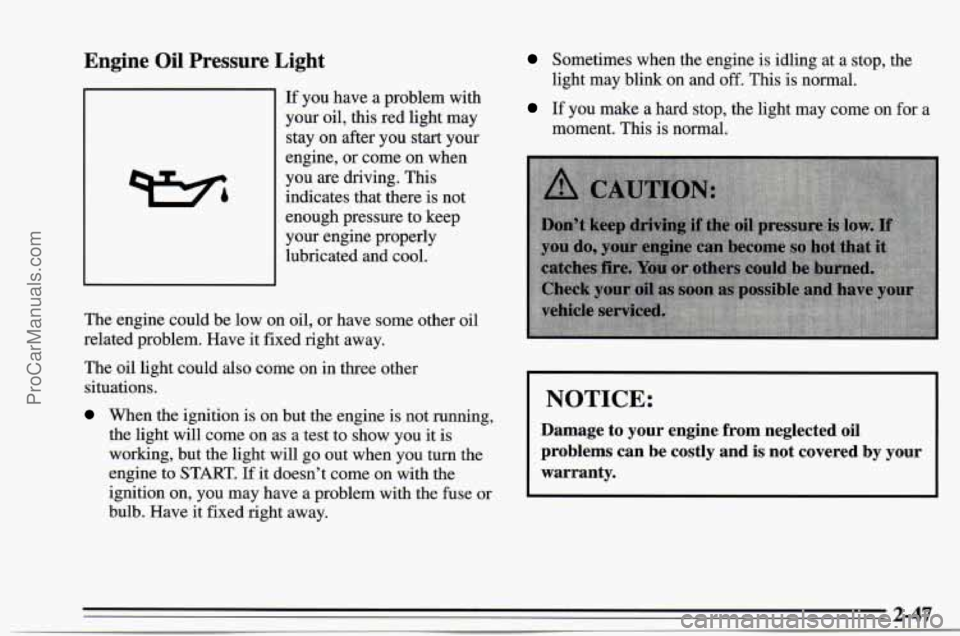
Engine Oil Pressure Light
If you have a problem with
your oil, this red light may
stay on after you start your
engine, or come on when
you are driving. This
indicates that there is not
enough pressure to keep
your engine properly
lubricated and cool.
The engine could be low on oil, or have some other oil
related problem. Have
it fixed right away.
The oil light could also come on in three other
situations.
When the ignition is on but the engine is not running,
the light will come on as a test to show you it is
working, but the light will go out when you turn the
engine to START.
If it doesn’t come on with the
ignition on, you may have a problem with the fuse
or
bulb. Have it fixed right away.
Sometimes when the engine is idling at a stop, the
If you make a hard stop, the light may come on for a
light
may blink on and
off. This is normal.
moment. This is normal.
I NOTICE:
Damage to your engine from neglected oil
problems can be costly and
is not covered by your
warranty.
ProCarManuals.com
Page 118 of 354
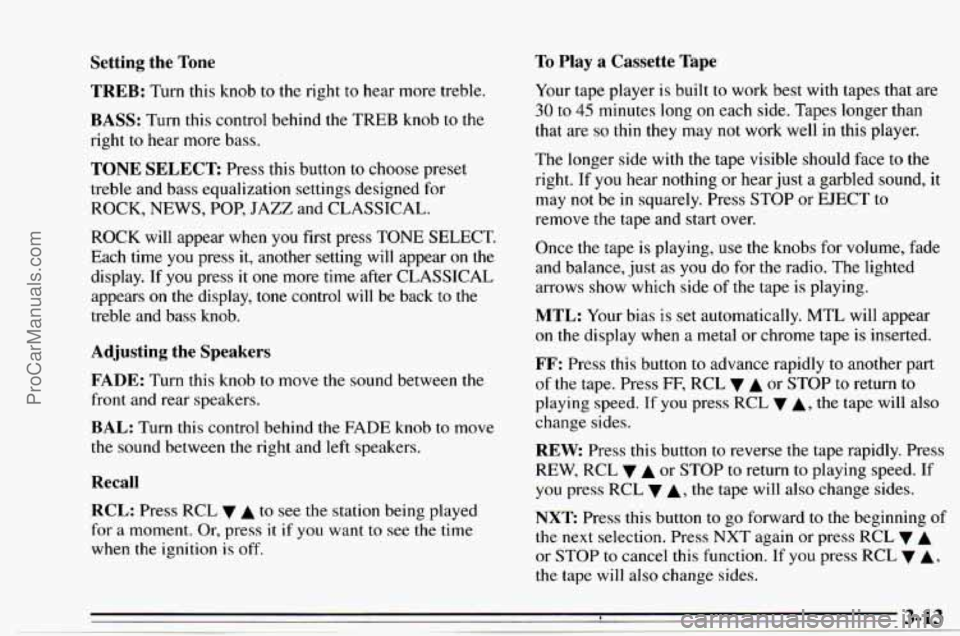
Setting the Tone To Play a Cassette Tape
Your tape player is built to work best with tapes that are
30 to 45 minutes long on each side. Tapes longer than
that are
so thin they may not work well in this player.
The longer side with the tape visible should face to the
right.
If you hear nothing or hear just a garbled sound, it
may not be in squarely. Press STOP or EJECT to
remove the tape
and start over.
TREB: Turn this knob to the right to hear more treble.
BASS: Turn this control behind the TREB knob to the
right
to hear more bass.
TONE SELECT Press this button to choose preset
treble and bass equalization settings designed for
ROCK, NEWS, POP, JAZZ and CLASSICAL.
ROCK will appear when you first press TONE SELECT.
Each time you press it, another setting will appear on the
display. If you press it one more
time after CLASSICAL
appears on
the display, tone control will be back to the
treble and bass
knob.
Adjusting the Speakers
FADE:
Turn this knob to move the sound between the
front and rear speakers.
BAL: Turn this control behind the FADE knob to move
the sound between the right and
left speakers.
Recall
RCL: Press RCL v A to see the station being played
for
a moment. Or, press it if you want to see the time
when the ignition is off. Once
the tape is playing,
use the knobs for volume, fade
and balance, just as you do for the radio. The lighted
arrows
show which side of the tape is playing.
MTL: Your bias is set automatically. MTL will appear
on the display
when a metal or chrome tape is inserted.
FF: Press this button to advance rapidly to another part
of the tape. Press
FF, RCL v A or STOP to return to
playing speed.
If you press RCL 7 A, the tape will also
change sides.
REW. Press this button to reverse the tape rapidly. Press
REW, RCL
v A or STOP to return to playing speed. If
you press RCL
A, the tape will also change sides.
NXT Press this button to go forward to the beginning of
the next selection. Press NXT again or press RCL v A
or STOP to cancel this function. If you press RCL v A,
the tape will also change sides.
8 3-13
- ~ ProCarManuals.com
Page 120 of 354
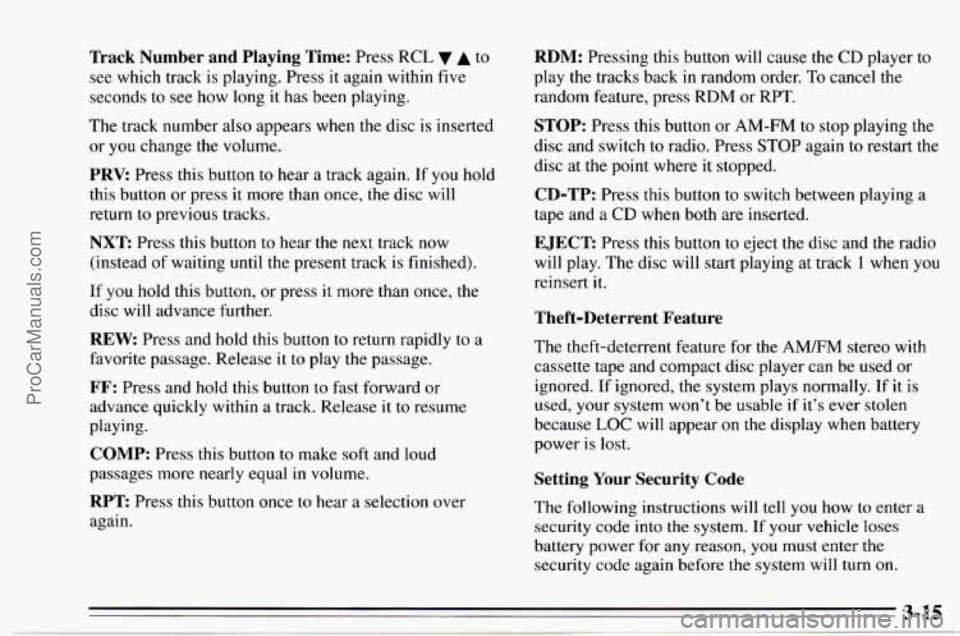
Track Number and Playing Time: Press RCL A to
see which track is playing. Press
it again within five
seconds to see how long
it has been playing.
The track number
also appears when the disc is inserted
or you change the volume.
PRV: Press this button to hear a track again. If you hold
this button or press
it more than once, the disc will
return to previous tracks.
NXT Press this button to hear the next track now
(instead of waiting
until the present track is finished).
If you hold this button, or press
it more than once, the
disc will advance further.
REW Press and hold this button to return rapidly to a
favorite passage. Release it to play the passage.
FF: Press and hold this button to fast forward or
advance quickly within a track. Release
it to resume
playing.
COMP: Press this button to make soft and loud
passages more nearly equal in volume.
RPT Press this button once to hear a selection over
again.
RDM: Pressing this button will cause the CD player to
play the tracks back
in random order. To cancel the
random feature, press RDM or RPT.
STOP: Press this button or AM-FM to stop playing the
disc and switch to radio. Press STOP again to restart the
disc
at the point where it stopped.
CD-TP: Press this button to switch between playing a
tape and a CD when both are inserted.
EJECT: Press this button to eject the disc and the radio
will play. The disc will start playing at track 1 when you
reinsert
it.
Theft-Deterrent Feature
The theft-deterrent feature for the AM/FM stereo with
cassette tape and compact disc player can be used or
ignored.
If ignored, the system plays normally. If it is
used, your system won't be usable
if it's ever stolen
because
LOC will appear on the display when battery
power
is lost.
Setting Your Security Code
The following instructions will tell you how to enter a
security code into the system. If your vehicle loses
battery power for any reason, you must enter the
security code again before the system will
turn on.
ProCarManuals.com
Page 136 of 354
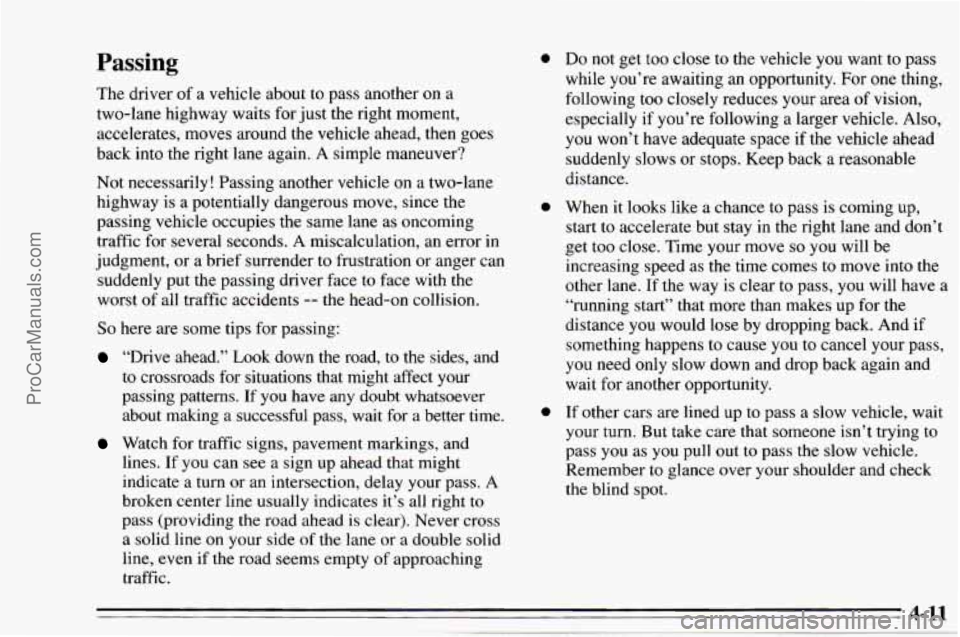
Passing
The driver of a vehicle about to pass another on a
two-lane highway waits for just the right moment,
accelerates, moves around the vehicle ahead, then goes
back into the right lane again. A simple maneuver?
Not necessarily! Passing another vehicle on a two-lane
highway is a potentially dangerous move, since the
passing vehicle occupies the same lane as oncoming
traffic for several seconds.
A miscalculation, an error in
judgment, or a brief surrender to frustration or anger can
suddenly put the passing driver face to face with the
worst
of all traffic accidents -- the head-on collision.
So here are some tips for passing:
“Drive ahead.” Look down the road, to the sides, and
to crossroads for situations that might affect your
passing patterns.
If you have any doubt whatsoever
about making a successful pass, wait for a better time.
Watch for traffic signs, pavement markings, and
lines.
If you can see a sign up ahead that might
indicate a turn or an intersection, delay your pass.
A
broken center line usually indicates it’s all right to
pass (providing the road ahead is clear). Never cross
a solid line on your side
of the lane or a double solid
line, even if the road seems empty
of approaching
traffic.
0 Do not get too close to the vehicle you want to pass
while you’re awaiting
an opportunity. For one thing,
following too closely reduces your area of vision,
especially
if you’re following a larger vehicle. Also,
you won’t have adequate space if the vehicle ahead
suddenly slows or stops. Keep back a reasonable
distance.
0 When it looks like a chance to pass is coming up,
start to accelerate but stay in the right lane and don’t
get too close. Time your move
so you will be
increasing speed as the time comes to move into the
other lane.
If the way is clear to pass, you will have a
“running start” that more than makes up for the
distance you would lose
by dropping back. And if
something happens to cause you to cancel your pass,
you need only slow down and drop back again and
wait for another opportunity.
0 If other cars are lined up to pass a slow vehicle, wait
your turn. But take care that someone isn’t trying to
pass you as you pull
out to pass the slow vehicle.
Remember to glance over your shoulder and check
the blind spot.
ProCarManuals.com